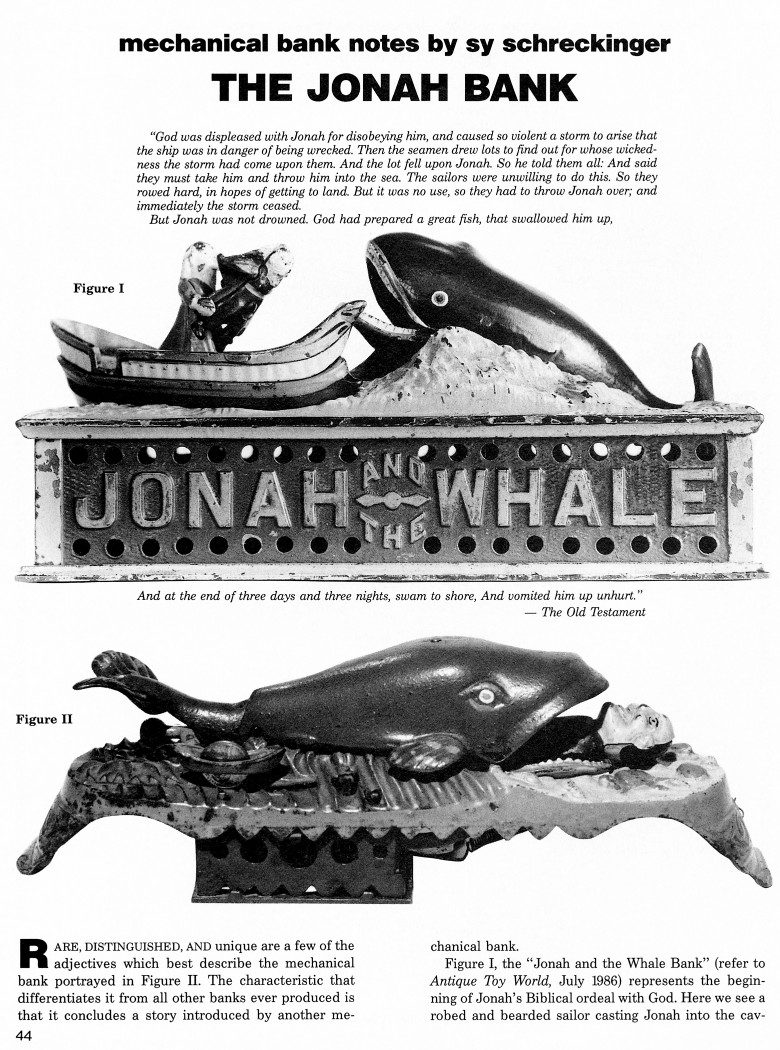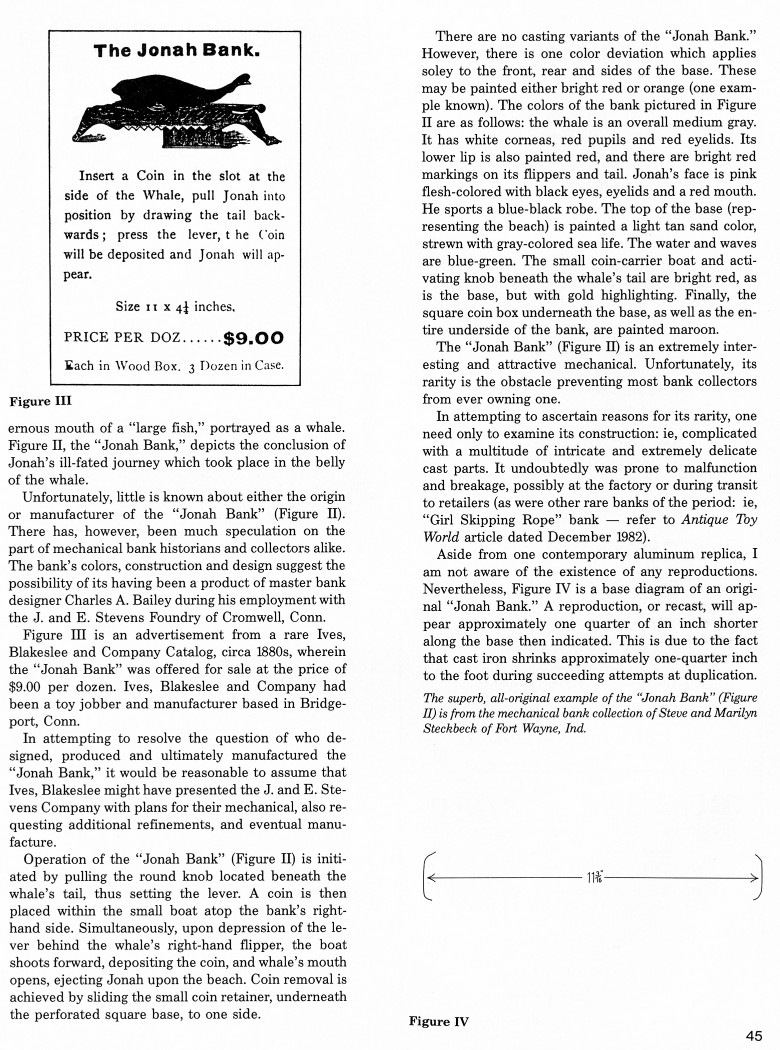|
The Jonah Bank
by Sy Schreckinger – ANTIQUE TOY WORLD Magazine – July, 1994
"God was displeased with Jonah for disobeying
him, and caused so violent a storm to arise that the ship was in danger of
being wrecked. Then the seamen drew lots to find out for whose wickedness
the storm had come upon them. And the lot fell upon Jonah. So he told them
all: And said they must take him and throw him into the sea. The sailors
were unwilling to do this. So they rowed hard, in hopes of getting to
land. But it was no use, so they had to throw Jonah over; and immediately
the storm ceased.
But Jonah was not drowned. God had prepared a great fish, that
swallowed him up, and at the end of three days and three nights, swam to
shore, And vomited him up unhurt."
— The Old Testament
Rare , distinguished, and unique are a few of the adjectives which
best describe the mechanical bank portrayed in Figure II. The
characteristic that differentiates it from all other banks ever produced
is that it concludes a story introduced by another mechanical bank.
Figure I, the "Jonah and the Whale Bank" (refer to Antique Toy World,
July 1986) represents the beginning of Jonah's Biblical ordeal with God.
Here we see a robed and bearded sailor casting Jonah into the cavernous
mouth of a "large fish," portrayed as a whale. Figure II, the "Jonah
Bank," depicts the conclusion of Jonah's ill-fated journey which took
place in the belly of the whale.
Unfortunately, little is known about either the origin or
manufacturer of the "Jonah Bank" (Figure II). There has, however, been
much speculation on the part of mechanical bank historians and collectors
alike. The bank's colors, construction and design suggest the possibility
of its having been a product of master bank designer Charles A. Bailey
during his employment with the J. and E. Stevens Foundry of Cromwell,
Conn.
Figure III is an advertisement from a rare Ives, Blakeslee and
Company Catalog, circa 1880s, wherein the "Jonah Bank" was offered for
sale at the price of $9.00 per dozen. Ives, Blakeslee and Company had been
a toy jobber and manufacturer based in Bridgeport, Conn. In attempting to
resolve the question of who designed, produced and ultimately manufactured
the "Jonah Bank," it would be reasonable to assume that Ives, Blakeslee
might have presented the J. and E. Stevens Company with plans for their
mechanical, also requesting additional refinements, and eventual
manufacture.
Operation of the "Jonah Bank" (Figure II) is initiated by pulling the
round knob located beneath the whale's tail, thus setting the lever. A
coin is then placed within the small boat atop the bank's right-hand side.
Simultaneously, upon depression of the lever behind the whale's right-hand
flipper, the boat shoots forward, depositing the coin, and whale's mouth
opens, ejecting Jonah upon the beach. Coin removal is achieved by sliding
the small coin retainer, underneath the perforated square base, to one
side.
There are no casting variants of the "Jonah Bank." However, there is
one color deviation which applies solely to the front, rear and sides of
the base. These may be painted either bright red or orange (one example
known). The colors of the bank pictured in Figure II are as follows: the
whale is an overall medium gray. It has white corneas, red pupils and red
eyelids. Its lower lip is also painted red, and there are bright red
markings on its flippers and tail. Jonah's face is pink flesh-colored with
black eyes, eyelids and a red mouth. He sports a blue-black robe. The top
of the base (representing the beach) is painted a light tan sand color,
strewn with gray-colored sea life. The water and waves are blue-green. The
small coin-carrier boat and activating knob beneath the whale's tail are
bright red, as is the base, but with gold highlighting. Finally, the
square coin box underneath the base, as well as the entire underside of
the bank, are painted maroon.
The "Jonah Bank" (Figure II) is an extremely interesting and
attractive mechanical. Unfortunately, its rarity is the obstacle
preventing most bank collectors from ever owning one.
In attempting to ascertain reasons for its rarity, one need only to
examine its construction: i.e., complicated with a multitude of intricate
and extremely delicate cast parts. It undoubtedly was prone to malfunction
and breakage, possibly at the factory or during transit to retailers (as
were other rare banks of the period: i.e., "Girl Skipping Rope" bank — refer
to Antique Toy World article dated
December 1982).
Aside from one contemporary aluminum replica, I am not aware of the
existence of any reproductions. Nevertheless, Figure IV is a base diagram
of an original "Jonah Bank." A reproduction, or recast, will appear
approximately one quarter of an inch shorter along the base then
indicated. This is due to the fact that cast iron shrinks approximately
one-quarter inch to the foot during succeeding attempts at duplication.
The superb, all-original example of the "Jonah Bank" (Figure II) is
from the mechanical bank collection of Steve and Marilyn Steckbeck of Fort
Wayne, Ind.
|


